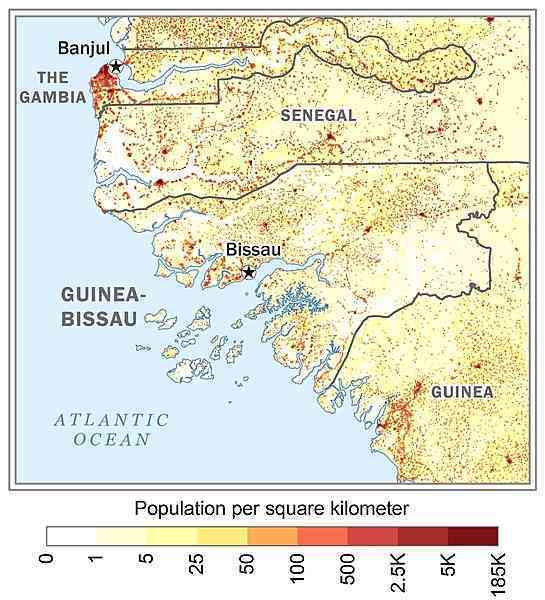
Western Africa, bordering the North Atlantic Ocean, between Guinea and Senegal
12 00 N, 15 00 W
Africa
total: 36,125 sq km
land: 28,120 sq km
water: 8,005 sq km
slightly less than three times the size of Connecticut
total: 762 km
border countries (2): Guinea 421 km; Senegal 341 km
350 km
territorial sea: 12 nm
exclusive economic zone: 200 nm
tropical; generally hot and humid; monsoonal-type rainy season (June to November) with southwesterly winds; dry season (December to May) with northeasterly harmattan winds
mostly low-lying coastal plain with a deeply indented estuarine coastline rising to savanna in east; numerous off-shore islands including the Arquipelago Dos Bijagos consisting of 18 main islands and many small islets
highest point: Dongol Ronde 277 m
lowest point: Atlantic Ocean 0 m
mean elevation: 70 m
fish, timber, phosphates, bauxite, clay, granite, limestone, unexploited deposits of petroleum
agricultural land: 44.8% (2018 est.)
arable land: 8.2% (2018 est.)
permanent crops: 6.9% (2018 est.)
permanent pasture: 29.7% (2018 est.)
forest: 55.2% (2018 est.)
other: 0% (2018 est.)
250 sq km (2012)
Senegalo-Mauritanian Basin
approximately one-fifth of the population lives in the capital city of Bissau along the Atlantic coast; the remainder is distributed among the eight other, mainly rural, regions as shown in this 
hot, dry, dusty harmattan haze may reduce visibility during dry season; brush fires
this small country is swampy along its western coast and low-lying inland
NOTE: The information regarding Guinea Bissau on this page is re-published from the 2024 World Fact Book of the United States Central Intelligence Agency and other sources. No claims are made regarding the accuracy of Guinea Bissau 2024 information contained here. All suggestions for corrections of any errors about Guinea Bissau 2024 should be addressed to the CIA or the source cited on each page.
This page was last modified 04 May 24, Copyright © 2024 ITA all rights reserved.